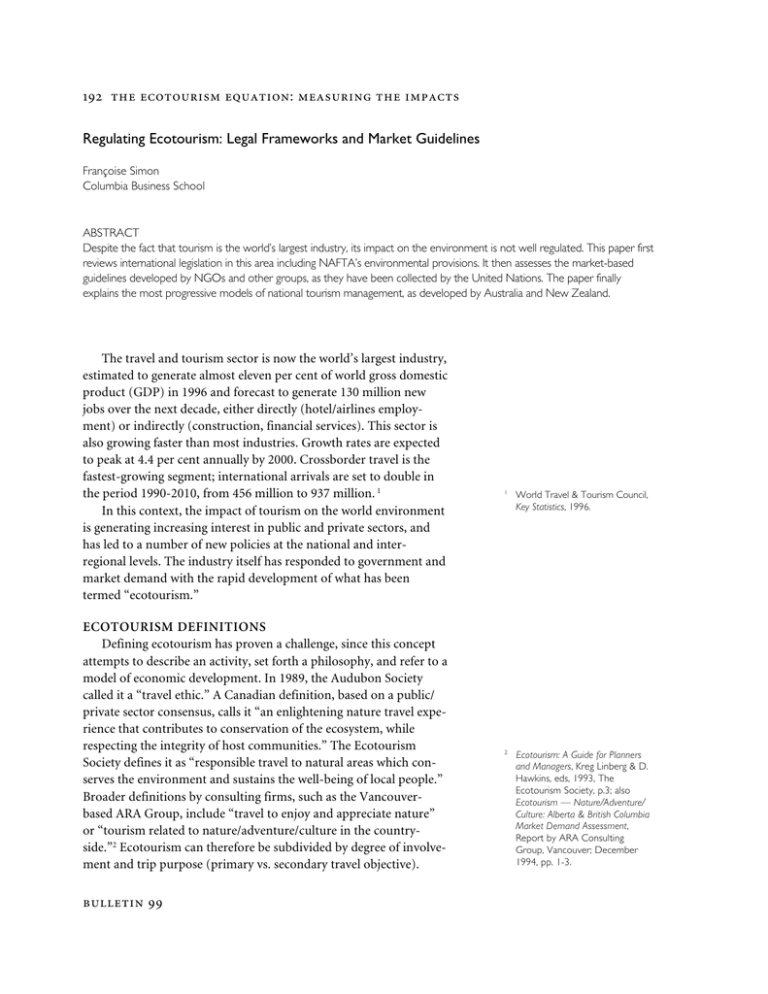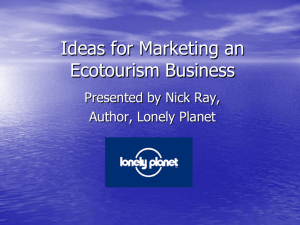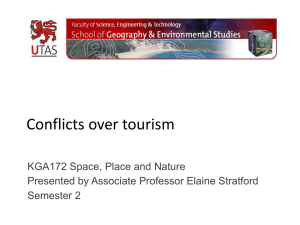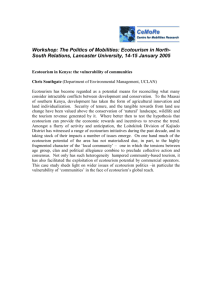Regulating Ecotourism: Legal Frameworks and Market Guidelines
advertisement

: Regulating Ecotourism: Legal Frameworks and Market Guidelines Françoise Simon Columbia Business School ABSTRACT Despite the fact that tourism is the world’s largest industry, its impact on the environment is not well regulated. This paper first reviews international legislation in this area including NAFTA’s environmental provisions. It then assesses the market-based guidelines developed by NGOs and other groups, as they have been collected by the United Nations. The paper finally explains the most progressive models of national tourism management, as developed by Australia and New Zealand. The travel and tourism sector is now the world’s largest industry, estimated to generate almost eleven per cent of world gross domestic product (GDP) in 1996 and forecast to generate 130 million new jobs over the next decade, either directly (hotel/airlines employment) or indirectly (construction, financial services). This sector is also growing faster than most industries. Growth rates are expected to peak at 4.4 per cent annually by 2000. Crossborder travel is the fastest-growing segment; international arrivals are set to double in the period 1990-2010, from 456 million to 937 million. 1 In this context, the impact of tourism on the world environment is generating increasing interest in public and private sectors, and has led to a number of new policies at the national and interregional levels. The industry itself has responded to government and market demand with the rapid development of what has been termed “ecotourism.” ECOTOURISM DEFINITIONS Defining ecotourism has proven a challenge, since this concept attempts to describe an activity, set forth a philosophy, and refer to a model of economic development. In 1989, the Audubon Society called it a “travel ethic.” A Canadian definition, based on a public/ private sector consensus, calls it “an enlightening nature travel experience that contributes to conservation of the ecosystem, while respecting the integrity of host communities.” The Ecotourism Society defines it as “responsible travel to natural areas which conserves the environment and sustains the well-being of local people.” Broader definitions by consulting firms, such as the Vancouverbased ARA Group, include “travel to enjoy and appreciate nature” or “tourism related to nature/adventure/culture in the countryside.”2 Ecotourism can therefore be subdivided by degree of involvement and trip purpose (primary vs. secondary travel objective). 1 World Travel & Tourism Council, Key Statistics, 1996. 2 Ecotourism: A Guide for Planners and Managers, Kreg Linberg & D. Hawkins, eds, 1993, The Ecotourism Society, p.3; also Ecotourism — Nature/Adventure/ Culture: Alberta & British Columbia Market Demand Assessment, Report by ARA Consulting Group, Vancouver; December 1994, pp. 1-3. A 1994 North American study found significant differences between primary and secondary travel groups. Each was mostly between 25 and 54 years of age, but the ecotourism group (primary) had higher education levels and a higher willingness to spend (45 per cent willing to spend over $1,500 per person on an ecotourism vacation, as opposed to 38 per cent of the secondary traveler group interested in nature).3 ECOTOURISM: SIZE AND GROWTH Because of this broad range of ecotourist definitions, the ecotourism market has been notoriously difficult to assess, and estimates vary a great deal among the main markets of origin. A 1992 survey by the U.S. Travel Data Center showed that 7.0 per cent of U.S. travelers (8 million) had taken at least one ecotourism trip, and 30 per cent (35 million) planned to take one within the next three years. The Center also reported a 330 per cent growth in international visitors to U.S. national parks in the 1985-91 period (63,500 visits in 1985 vs. 273,400 in 1991). Non-North American originating markets show great variations according to the source of the estimate. The World Travel & Tourism Council estimates only 4.0 per cent of European outbound travel to be ecotourism-based, but the Ecotourism Society ranks 40 to 60 per cent of all international arrivals to be nature-oriented. International arrivals grew from 393 million in 1988 to over 528 million in 1994. The Ecotourism Society has estimated 157-236 million to be natureoriented in 1988 and 211-317 million in 1994.4 The best market estimates may have been achieved to date for traditional ecotourism destinations. A World Wildlife Fund 1990 survey of tourists to Mexico, Belize, Dominica, Costa Rica, and Ecuador, for instance, found 41 to 75 per cent of travelers visiting protected nature areas.5 Costa Rica has become one of the top destinations in the 1990s, and the scope and impact of its ecotourism has been relatively wellresearched in government studies. International arrivals to Costa Rica grew by 37 per cent in only three years, from 500,000 in 1991 to 684,000 in 1993. Tourism receipts reached $577 million in 1993. A survey commissioned by the National Park Service in 1992 showed that visitors to forested areas increased from 18 per cent in 1982 to 54 per cent in 1991.6 Given this rapid growth of tourism involving nature areas, policymakers are reviewing existing legislation and taking initiatives at the international, regional, and national levels. 3 Ecotourism/Nature/Adventure/ Culture, ARA Report, op. cit., pp. 212. 4 U.S. Travel Data Center, U.S. Travel Survey, 1992; World Travel & Tourism Council, 1995 statistics; Ecotourism Society, 1995 (oral communication). 5 World Wildlife Fund, Survey of Ecotourism Travel to Central America, 1990. 6 Evolucion del Turismo en las Areas Silvestres, report by Fernando Bermudez for the National Park Service/Ministry of Natural Resources, Energy and Mining, Costa Rica, 1992, p.6. : INTERNATIONAL LEGISLATION Presently, environmental law is not a distinct field. Environmental provisions appear in criminal, property, construction, and water law. Environmental law is also characterized by fragmentation. In the U.S., states such as New York and Illinois have adopted constitutional provisions to protect the environment, but no federal amendment has been implemented. In Europe, an EEA (European Economic Area) accord has environmental provisions, but member states retain their own regulations. In Germany, as in the U.S., states like Bavaria are often ahead of the federal government. Constitutional provisions exist in several countries. In Spain and Portugal, protection of the environment is seen as a fundamental social right and entails a constitutional claim for compensation. Guidelines for the state are provided by other European Union members such as the Netherlands. International environmental law, as it is currently understood, began in 1972 with the UN Stockholm Conference. Prior to that, some three dozen environmental, multilateral treaties had been signed. The most comprehensive was the 1942 Western Hemisphere Convention, now under re-examination. By contrast, several hundred bilateral and multilateral agreements were concluded between the 1972 Stockholm Conference and the 1992 Rio Conference (UNCED). Most notable among these were CITES in 1973 on international trade in endangered species, the Montreal Protocol in 1987 on control of fluorocarbons emissions, the Helsinki Protocol on sulfur emissions, the Law of the Sea Treaty in 1982 and the 1989 Basel Convention on trade in hazardous waste. In 1987, the World Commission on Environment and Development’s Bruntland Report reflected a major shift from a transboundary to a global, interactive approach. It viewed development as sustainable only through integration of economic planning with conservation, cultural compatibility, and local input. More recently, the North American Free Trade Agreement (NAFTA) was the first trade agreement to include provisions aimed at protecting the environment. In particular, NAFTA prohibits the erosion of national standards to promote investment, reaffirms international agreements, and encourages the harmonization of standards among the three signatory states (Canada, the U.S., and Mexico). NAFTA was the focus of intense controversy regarding the environment, but after initial resistance, six major environmental groups, totaling 7.5 million members, backed NAFTA. However, NAFTA shows the potential for another type of conflict related to rules of the General Agreement on Trade and Tariffs (GATT) and the World Trade Organization (WTO). GATT and now the WTO allow member countries to adopt and enforce envi- More recently, the North American Free Trade Agreement (NAFTA) was the first trade agreement to include provisions aimed at protecting the environment. ronmental measures, but qualify it in two ways: 1) Countries are prohibited from using environmental standards as disguised barriers to trade; and 2) standards cannot be applied in a discriminatory way. This ambiguity has already led to some disputes, including the first U.S./Mexico conflict over dolphin-free tuna fishing in the Eastern Pacific Ocean. Mexico interprets the U.S. dolphin protection measures as a disguised trade barrier. MARKET-BASED GUIDELINES Given the ambiguous and fragmented nature of international agreements, the last decade has seen a proliferation of voluntary codes of conduct generated by non-governmental organizations (NGOs), tour operators, public land managers, and local community groups. A 1990 survey found 60 sets of guidelines developed by these various groups, each stressing a different priority. NGOs and tour operators tended to focus on habitat protection and human impact; public land managers on endangered species and protected areas; and local groups on culturally responsible tourism. In 1995, the United Nations Environment Programme (UNEP) listed 32 major environmental codes, from sources as diverse as the International Chamber of Commerce, the World Travel & Tourism Council, the New Zealand and Australia governments, and the English Tourist Board.7 These codes present two main implementation problems: measurement and funding. Their effectiveness remains impossible to assess, since none includes a quantitative framework for baseline measurement, target setting, final measurement, or monitoring. Funding is especially problematic. The Global Environmental Facility (GEF) was set up by the World Bank and other sources to finance projects related to biodiversity, ozone depletion, and other issues. One of its pilot projects in Latin America was discontinued, however, because of criticism by local community groups that the project reflected OECD issues rather than pressing local priorities. The most comprehensive industry code to date is contained in the WTTC/WTO/Earth Council Report, “Agenda 21 for the Travel and Tourism Industry,” which translates UNCED into an action program. The report sets nine priorities for trade organizations, including environmental assessments for any new operation, training and public awareness programs, and progress measurement at local levels. The document also includes ten priorities for private sector companies, ranging from waste reduction/reuse/recycling to water and land use management, local community involvement, and design for sustainability. Both sets of priorities rely on public/private sector partnerships for implementation.8 Although many governments have begun to develop policies to control the environmental impact of tourism, Australia and New Zealand have made the most progress in releasing comprehensive guidelines, in part because of tourism’s importance to their economies. 7 Environmental Codes of Conduct for Tourism, UNEP (United Nations Environment Programme), Technical Report No.29, 1995, p.ii. 8 World Travel & Tourism Council, Agenda 21 for the Travel & Tourism Industry, 1995. : NATIONAL TOURISM MANAGEMENT MODELS Although many governments have begun to develop policies to control the environmental impact of tourism, Australia and New Zealand have made the most progress in releasing comprehensive guidelines, in part because of tourism’s importance to their economies. Tourism is Australia’s largest export industry, accounting for almost 12 per cent of the country’s export earnings in 1993-4 and employing, directly or indirectly, over 6 per cent of the workforce. Total international arrivals were expected to reach 3.4 million in 1995 and almost double, to 6.3 million, in the year 2000. Nature is also a major component of the Australian tourism product; key national parks recorded a four-fold increase in the number of visitors between 1982 and 1991, and a government survey showed that 53 per cent of adult Australians planned a nature-based trip within the next twelve months.9 Accordingly, the Australian government released in December 1992 its National Strategy For Ecologically Sustainable Development. The strategy was developed through a wide process of public consultation, including workshops in all states and territories and discussion with industry, conservation, and community groups. The Australian Conservation Foundation and the World Wide Fund for Nature have endorsed its pioneering approach. Canada, Denmark, Sweden, South Africa, the Netherlands and the U.S. are studying its applicability to their national environments. The National Strategy is a package of complementary ecotourism initiatives reflecting the fact that the Australian ecotourism industry is characterized by small-scale operations offering personalized service. The main provisions include: • • • • a feasibility study for an accreditation system for private sector companies. an education program for the media, the tourism industry, and consumers. extensive market research to assess the nature and level of demand. a study to improve the business skills and knowledge base of ecotourism operators. The Australian government’s commitment to the implementation of this strategy includes funding of $10 million over four years starting in 1993-4.10 9 Barbara Jones and Tanya Tear, “Australia’s National Ecotourism Strategy,” Industry and Environment, (UNEP), January - March 1995, p.55. 10 Ibid. CONCLUSION Despite varying size and growth estimates, it seems clear that the scope and impact of tourism and ecotourism will continue to grow and will require international regulation. But the current legal framework is a patchwork of agreements and treaties that concern trade more than tourism and are often in conflict. Although international bodies such as UNEP and the WTTC are moving toward a unified set of guidelines, their implementation will remain problematic due to a lack of systematic measurement and enforcement. The best way of regulating tourism may be found in strategic plans, like the one recently developed by Australia. Such plans base their effectiveness on a regional approach, recognize local ecosystems as their foundation, involve local participation in the planning and decision-making process, and include a long-term funding commitment at the national level. FRANÇOISE SIMON Françoise Simon is a professor of marketing and international business at the Columbia Business School and also manages her own international consulting firm. She has over fifteen years of experience in consulting and marketing management in the U.S., Europe, Asia, and Africa, including as a Principal of Ernst & Young and a Director of Arthur D. Little. She has been involved with projects such as a USAID-funded study for 25 Caribbean governments, determining the feasibility of a pan-Caribbean promotion campaign in the U.S. Market. She earned an MBA from Northwestern University and a doctorate from Yale University. Françoise Simon, Phone: (914) 961-5322, Fax: (914) 961-7422.

![Ecotourism_revision[1]](http://s2.studylib.net/store/data/005398532_1-116d224f2d342440647524cbb34c0a0a-300x300.png)





